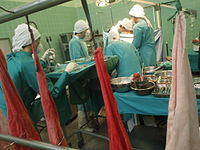
Photo from wikipedia
Background We assessed the prognostic impact of donor age on the outcome of adult living donor liver transplantation (LDLT). Material/Methods The study population comprised adult donor and recipients of right… Click to show full abstract
Background We assessed the prognostic impact of donor age on the outcome of adult living donor liver transplantation (LDLT). Material/Methods The study population comprised adult donor and recipients of right lobe grafts for LDLT performed from January 2005 to December 2016. There were 35 living donors aged ≥50 years (old-age donor group). As a control group, donors in their 20s (young-age donor group) were selected after one-to-one propensity score matching based on sex, model for end-stage liver disease (MELD) score, and primary diagnosis. Results Donor age was 52.5±1.5 years versus 25.4±3.1 years in the old- and young-age donor groups, respectively. Remnant volumes of the 2 groups were 38.9±3.0% versus 38.1±2.9%, respectively (p=0.98). One-month regeneration rate of the remnant liver was 101.1±10.6% versus 104.5±11.8%, respectively (p=0.08), and there was no significant difference in the incidences of donor complications. Mean MELD score was 15 versus 14, respectively (p=0.82). Graft-to-recipient weight ratio was 1.02±0.43 versus 0.91±0.63, respectively (p=0.28). In the recipients, biliary complication occurred in 11.4% versus 8.6%, respectively (p=0.12), and there was no difference in 5-year survival rates of both groups (p=0.15). The 1-week and 1-month regeneration rates of the remnant left liver were 71.6±9.9% and 100.1±10.6% in the old-age group, respectively, whereas those were 80.2±12.1% and 104.5±11.8% in the young-age group, respectively (p=0.08). Conclusions Right lobe grafts from donors aged ≥50 years showed the usual recovery of graft function but rather delayed liver regeneration. Thus, old-aged donors should be selected prudently after consideration of hepatic resection rate, graft size, and hepatic steatosis.
Journal Title: Annals of Transplantation
Year Published: 2018
Link to full text (if available)
Share on Social Media: Sign Up to like & get
recommendations!